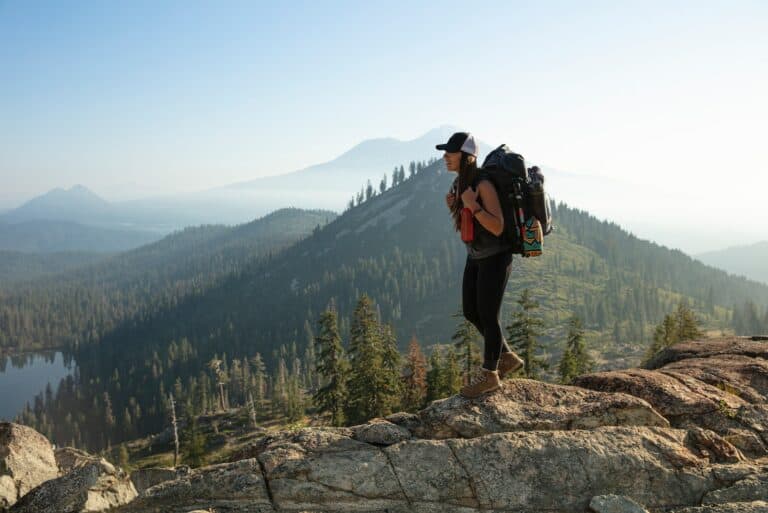Venturing into the wonderful world of outdoor exploration for your initial hiking experience? How thrilling! I recall my inaugural trek through the trails, filled with a mix of uncertainty and enthusiasm for the impending adventure. Embarking on a hike for the first time offers a splendid opportunity to commune with nature, enhance your fitness, and push your boundaries. Yet, truth be told, for newcomers, it can feel a tad overwhelming. Now, let’s delve into some essential first hike tips to make your introduction to the trails smoother.
Choosing the Right Trail

Stepping into the hiking world, the choice of trail is instrumental for a good or bad experience. In my years of hiking, I’ve learned you should never underestimate the importance of selecting the right trail.
When out exploring nature, it’s essential to remember that not all trails are created equal. Each trail has its unique challenges that vary according to factors like length, elevation, and terrain.
Here are a few tips to help you in picking the right trail for your first hike:
- Research before you go: Get to know the trail before you set foot on it. Going in blind can lead to unpleasant surprises. It’s always a good idea to research the trails within your travel reach.
- Beginner-friendly trails: For beginners, it’s best to start with a simple trail. These are shorter, less elevated, and marked trails that will still deliver the satisfaction of conquering a hike.
- Trail length: Determine how long you can hike before getting tired. It’s better to underestimate your abilities when you’re starting. Choose a trail you can complete in 3-4 hours.
- Know the trail conditions: Make sure to know the current weather conditions and how they affect the trail. This information is usually available on local park websites.
Remember, the best trail is one that matches your current hiking abilities. Don’t rush yourself and gradually build your hiking skills. After all, it’s not a race but a journey to appreciate nature’s beauty and embrace the joy of hiking.
In the following section, we’ll discuss essential gear for your first hike, critical for safety and comfort on the trail. So let’s move on to that.
Essential Gear and Clothing
When you’re preparing for your first hike, it’s critical that you pack the right gear and wear appropriate clothing. Here’s a breakdown of what you’ll need:
Gear: It’s important to have a reliable backpack that can safely store all your essentials. For beginners, I’d recommend a 20 to 30 liter backpack.
Another must-have is a detailed trail map or a guiding app on your smartphone. Even on well-marked trails, getting lost is easier than you might think!
A first aid kit may seem overly cautious to some, but even a brief hike can involve scrapes, stings, or sprains. It’s always better to be prepared.
Don’t forget a water bottle or even a hydration pack, especially for hotter days or longer hikes.
Clothing: Starting from the bottom, you’ll want a pair of comfortable hiking boots or walking shoes, preferably something waterproof. A blister can ruin even the most scenic hike, so make sure your footwear fits properly and is broken in before you hit the trail.
Next, moisture-wicking clothing is your friend. Avoid cotton as it retains moisture, which can lead to discomfort and even hypothermia under the wrong conditions. Opt for synthetic materials or wool instead.
Even in summer, I always advise packing a lightweight jacket or a sweatshirt. The weather can change drastically from the foot of a mountain to its peak.
Weather appropriate accessories are always a good idea. Think hats, gloves, or a buff. These can protect you from the sun, cold, or pesky insects.
Safety Precautions

Your hiking gear is all set, and you’re ready to hit the trails. But, wait! Let’s not forget to pay heed to Safety Precautions. It’s paramount to prioritize your safety on that upcoming first hike.
First and foremost, always remember the ‘buddy system’. Hiking alone might seem enticing but in the event of an emergency, you’ll want someone there to help. If you’re heading out on your own, at least let someone know your trail plan and estimated return time.
Aside from companionship, you need awareness of your surroundings. Before venturing out, get familiar with your chosen trail. Research about local wildlife, poisonous plants, or any other potential hazards. Familiarize yourself with the weather forecasts and sunrise or sunset times. While hiking, make sure to stay on marked trails, avoiding unknown routes.
Another requisite is the classic “leave no trace” principle. It not only aids in preserving nature but also ensures you don’t lead others astray with misleading tracks. Here’s what you need to do:
- Stick to trails; avoid making new ones
- Dispose of waste properly; carry a garbage bag if needed
- Respect wildlife and leave what you find
Lastly, keep a whistle at hand. It’s small, lightweight, and can be lifesaving. In an unfortunate circumstance where you lose your way or end up injured, a blasting whistle could alert your fellow hikers or rescue teams. Trust me, its piercing sound carries further than shouting.
Pack Smart and Light
Next on the agenda is packing – a crucial aspect of hiking that, if done smartly, can ensure you’re well-equipped yet not burdened. Remember, the goal for your first hike is to make it as enjoyable and stress-free as possible.
Your backpack is your lifeline during a hike. Ensure its contents are essentials that contribute to your comfort, safety, and sustenance. The first rule to follow is ‘Less is more.’ Packing light is paramount in hiking and could make the difference between a pleasurable hike and an arduous journey.
So what constitutes smart packing? Here’s a handy breakdown:
- Firstly, carry sufficient water and high-energy snacks. Hydration and sustenance are non-negotiable in the wilderness.
- Secondly, a basic first-aid kit for dealing with minor injuries or ailments is critical. This can include bandages, antiseptic cream, and pain relief meds for starters.
- Last but not least, pack according to the weather forecast. Consider layers of clothing that can be adjusted throughout the hike. Include a raincoat or poncho if there’s a hint of precipitation.
A pro tip to consider is that the bulk of your backpack’s weight should be closest to your back. This distributes the load more evenly, making it easier to carry.
Being prepared for first-time hiking doesn’t mean packing every piece of equipment you lay your eyes on. The balance lies in carrying essentials without overloading yourself. Utilizing the above tips should simplify your packing and ensure you’re ready to tackle the trial ahead.
Keep in mind, I’m focusing on basic day-hike essentials here – longer, overnight hikes would require additional gear, such as camping equipment and cooking tools. We’ll save that complexity for when you’re more accustomed to the hiking world.
Planning and Navigation

Thorough planning is the key to a successful first hike. It’s not just about packing smart and light—it’s also about knowing your trail. Start by researching the hiking trail. Consider factors like the trail’s difficulty level, length, and notable features. Be sure you’re choosing a trail that matches your fitness level.
Accurate maps are your best friend when it comes to trail hiking. Get your hands on a detailed, up-to-date map of the area you’ll be exploring. I recommend the US Geological Survey (USGS) topographical maps. These will show the terrain in detail, helping you know what to expect. Always keep this map in an easily accessible pocket.
Navigation skills are an essential part of hiking preparation. It’s not enough to merely have a map—you need to know how to use it. Learn about landmarks, contour lines, and compass directions. If possible, familiarize yourself with basic map-reading skills before you set out.
Remember to check the weather forecast for the area before leaving. Weather can be tremendously unpredictable in the wilderness, and sudden changes can be dangerous. Pack your gear and dress accordingly. It’s pivotal to be prepared for any situation that Mother Nature may throw at you.
Maybe one of the most overlooked aspects when planning a hike is letting someone know where you’re going and when you plan to return. In case of emergency, it is crucial that a friend or family member knows your location and expected return time.
Hiking can be a transformative experience if you’re adequately prepared. In addition to packing essentials like water, snacks, and a first-aid kit, remember the importance of planning your route and improving your navigation skills. It’s time to hit the trail with confidence and enjoy the great outdoors.
Conclusion: First Hike Tips
As we’ve journeyed through the essentials of a successful first hike, I hope you’ve gained a deeper understanding of the importance of preparation. Remember, it’s not just about the physical challenge, but also about being mentally ready and equipped with knowledge about your trail and navigation.
Don’t forget, safety should always be your top priority. Accurate maps, weather forecasts, and letting someone know your plans are not just suggestions, they’re necessities.
Lastly, embrace the transformative experience that hiking offers. It’s not just a walk in the park, it’s an adventure that can change how you see the world. So lace up your boots, pack your gear, and step into the great outdoors. Your first hike might just be the beginning of a lifelong passion.

